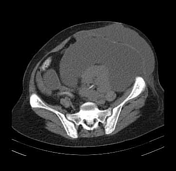Presentation
Renal transplant about 20 days ago.
Patient Data
Age: 25 years
Gender: Female
From the case:
Large complicated lymphocele due to renal transplant




Download
Info

Non-contrast CT scan shows large hypoattenuating collections with thin septations compressing renal graft. A post-transplant ureteric stent is well visualized with the distal end in an empty bladder, displaced by the sizable pelvic lymphocele.
Case Discussion
Perinephric fluid collections complicating a renal transplant are caused by :
- lymphocele: most common, occurring within 2 to 3 weeks after transplant
- urinoma: can occur at any time due to an anastomotic leak
- hematoma: higher CT density
- abscess: may contain gas




 Unable to process the form. Check for errors and try again.
Unable to process the form. Check for errors and try again.